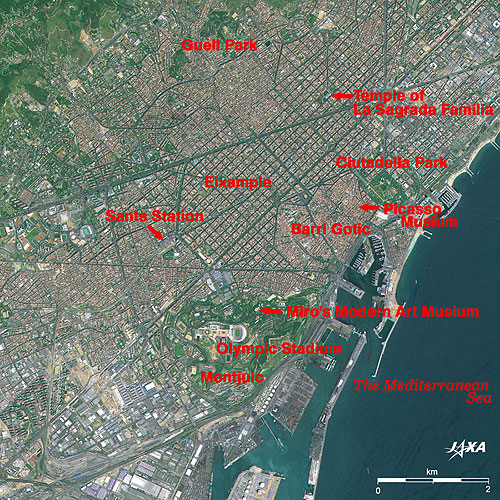Seen from Space 2006
Barcelona, Catalonia, Spain: Where the works of Gaudi and other artists are a prominent feature
The old city (Barri Gotic or Gothic Quarter) has prospered as a center of Barcelona for many years. Many Gothic style buildings are preserved in the old streetscape showing the vestige of medieval times. The Cathedral of Barcelona of the Catalonia Gothic rises high in the center of the old city. It took 150 years, from 1298 to 1448, to construct the Gothic Cathedral. Located beyond Frederic Mares Museum nearby is Plaza del Rey (Plaza of the King), where Christopher Columbus had an audience with Isabel la Catolica (Isabella the Catholic or Queen Isabella I of Spain) in 1493 after his return from the New World. In the new city (Example) area, the streets are set out neatly in a grid based on the city plan. The central Passeig de Gracia (Gracia Street) is a repository of Modernismo* architecture. Modernismo, which first came to Catalonia during the late 19th century, is a unique modern art and has created many everlasting masterpieces especially in architecture. The central figure in this style is Antoni Gaudí (1852-1926). Ciutadella Park on the eastside of the old city was landscaped at the site of the World Exposition held in 1888. Gaudi, who was a student at that time, participated in the construction, and his work can be seen throughout the Park. Gaudi's flavor in architecture is fully expressed in Palau Güell (Guell Park) in the northwestern part of the city. This 12ha park area creates a showplace of Gaudi's work such as waved benches, a peristyle of 100 pillars, and a collage of tiles on the hillside overlooking the city. In 1882 another architect, north of the city, started the construction of the temple of La Sagrada Família. In 1883, Gaudi took over this project and devoted himself to this work since 1914. This turned out to be his last project. The construction is continuing today even after his death. Pieces of Antoni Gaudi's work were added to the list of the World Heritage of the United Nations Educational, Scientific and Cultural Organization (UNESCO) in 1984. Other pieces of his work were added in 2005. In 1997, "Palau de la Música Catalana (Concert Hall of Catalonia) of Barcelona" and "Hospital de Sant Pau (Saint Pau Hospital)" built by Lluís Domènech i Montaner (1850-1923), a contemporary of Gaudi, were added to the World Heritage list . Catalonia produces many artists regarded as geniuses, and there are various art museums and museums in Barcelona. Joan Miró (1893-1983) was born in Barcelona. His works are found all over the town, including the Fundació Joan Miró (Joan Miro Foundation) Modern Art Museum in Montjuic. Pablo Picasso (1881-1973) moved to Barcelona in 1891 (when he was 13 or 14 years old) and the works of his earlier period in Barcelona, before he left for Paris in 1904, are mainly exhibited in the Museu de Picasso (Picasso Museum). The Montjuic in the southwest part of the city, blessed with a panoramic view of the city, is a large park covering over 220ha. It has an undulating green hill, reaching 173m above sea level. In addition to the main stadium of the Barcelona olympics, institutions such as Museu Nacional d'Art de Catalunya (National Museum of Art of Catalonia), Miro's Modern Art Museum, and Poble Espanyol Montjuic (Spanish Village) are located here. Palau Sant Jordi (Saint Jordi Sports Palace) Indoor Athletic Arena was designed by Japanese architect Arata Isozaki.
|
|||||||||||||||||||||||||||





